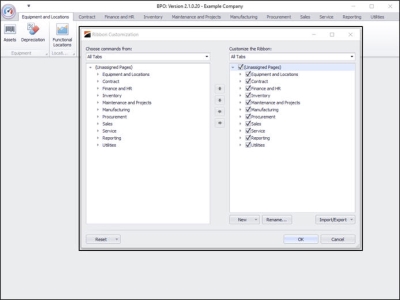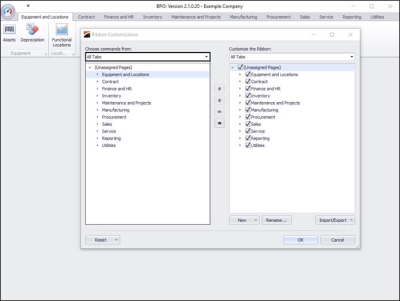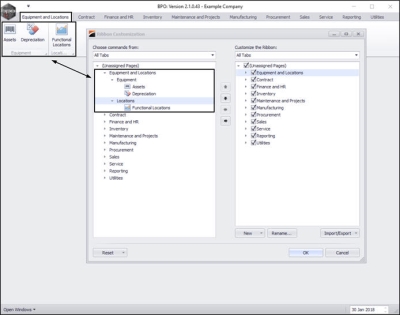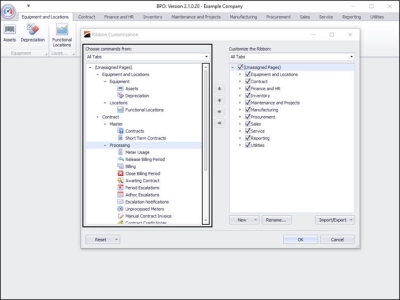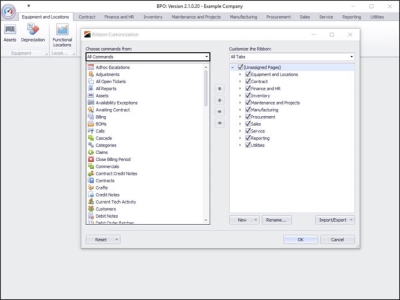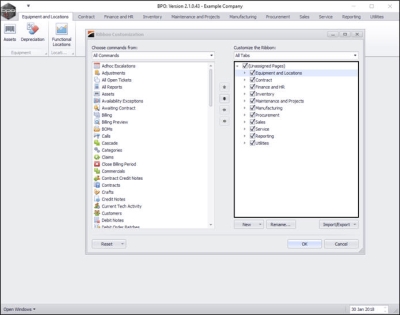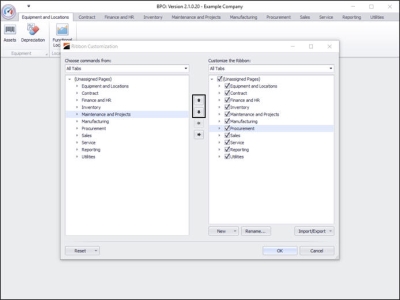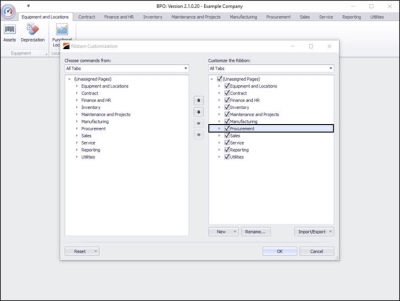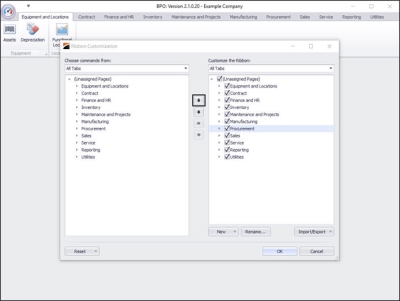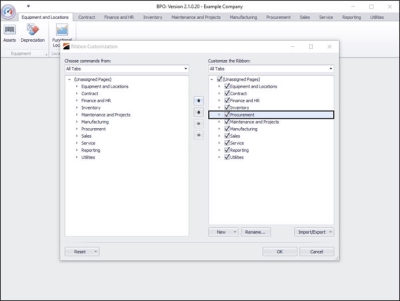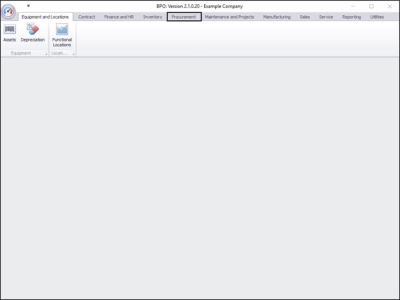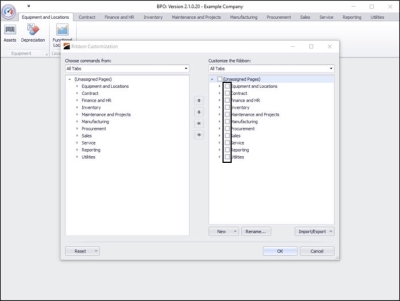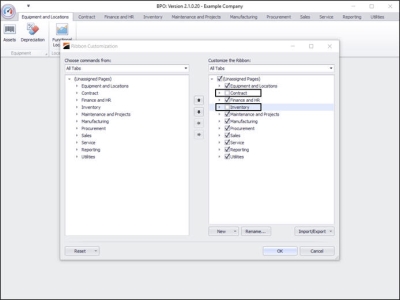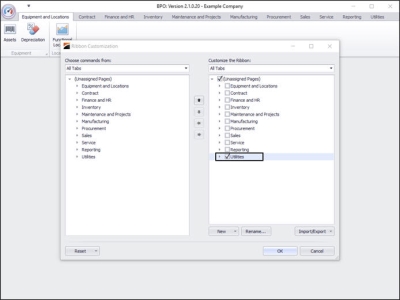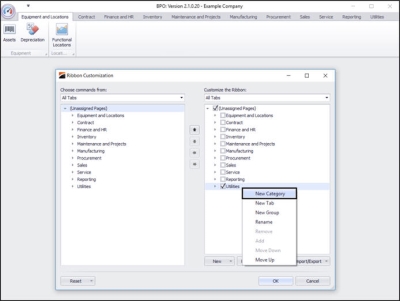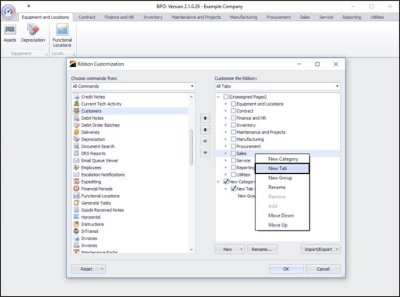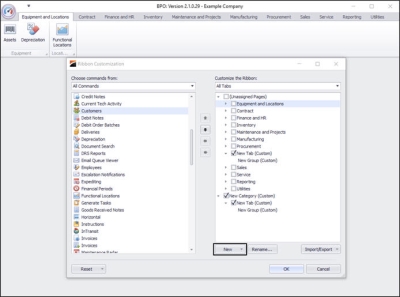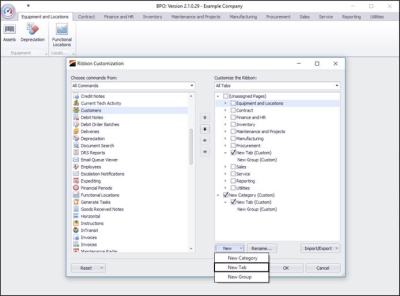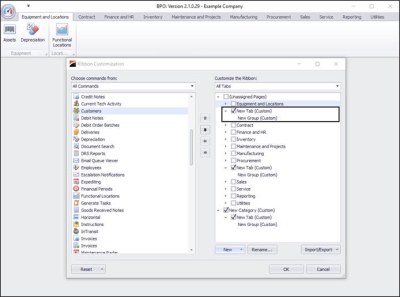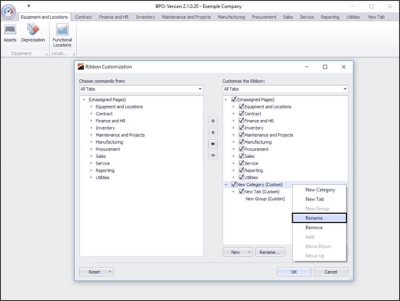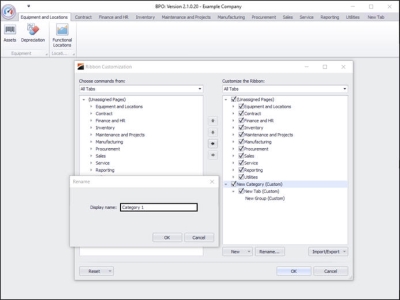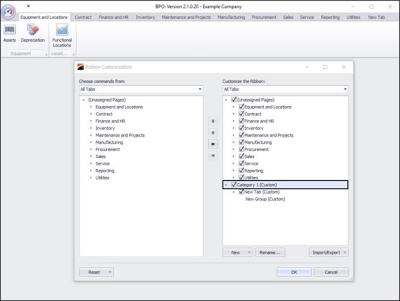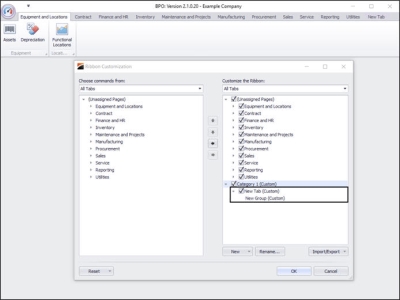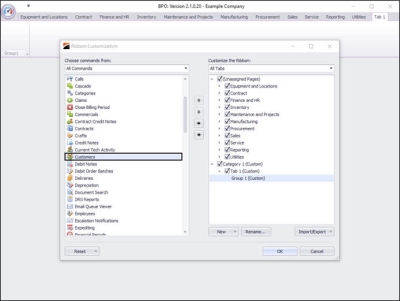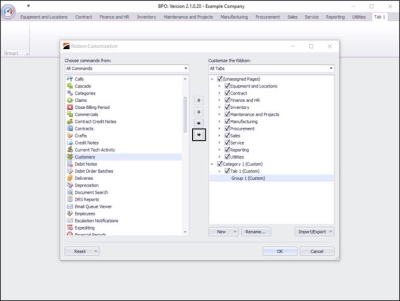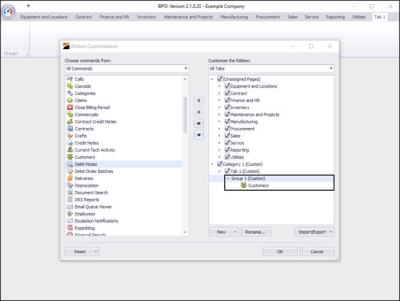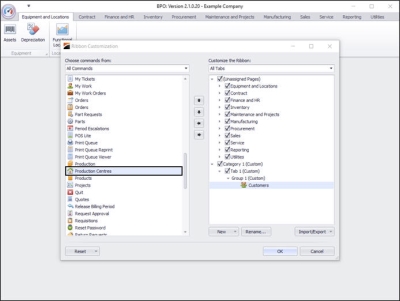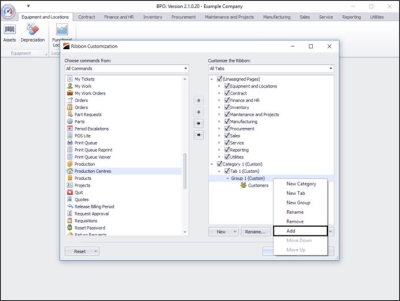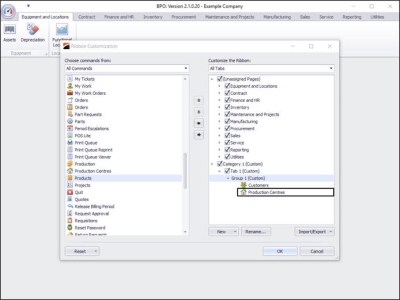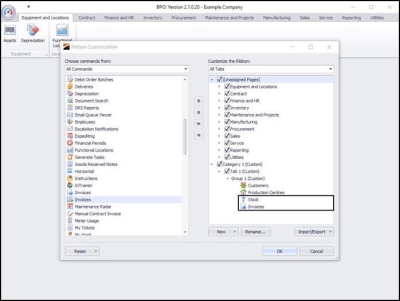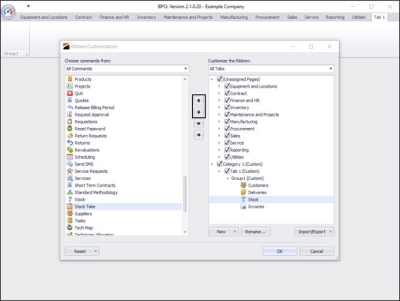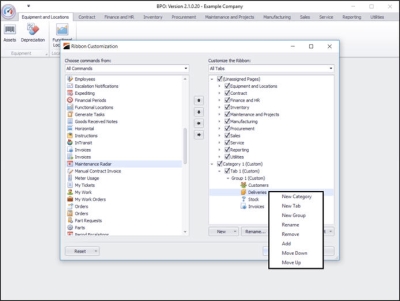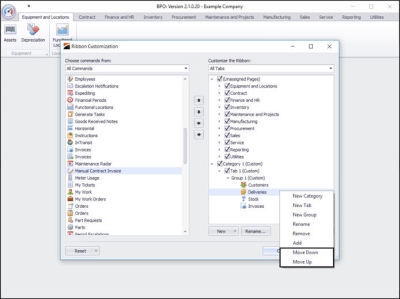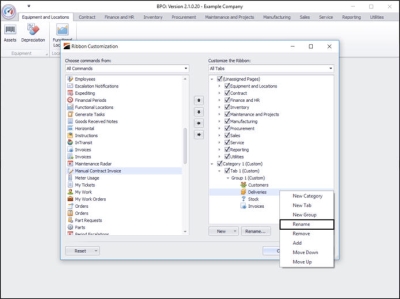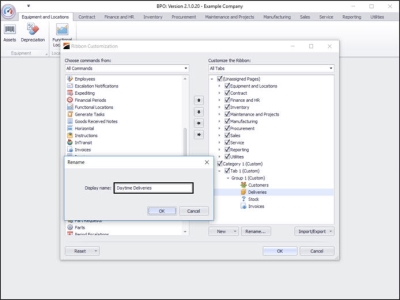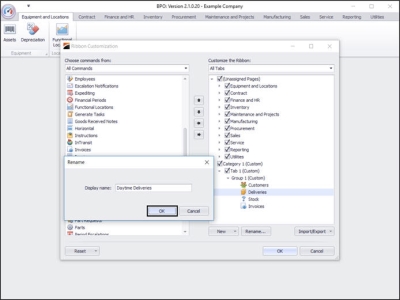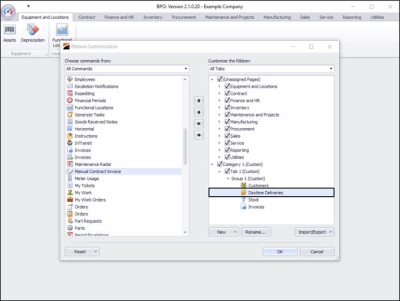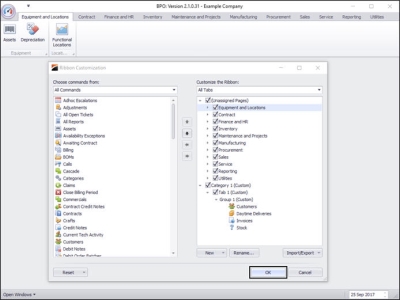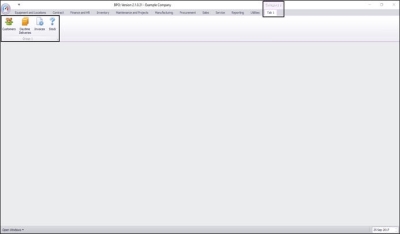Interface and Environment
Using BPO - Ribbon Configuration
You can customize the BPO ribbon to arrange tabs and commands in the order you want them, hide or unhide your ribbon, and hide those tabs and commands that you use less often.
| Ribbon Access: Quick Access Toolbar > Customize the Ribbon |
Ribbon Customization
- Click on the Quick Access Toolbar icon.
- A pop-up menu will appear with an option to Customize the Ribbon.
- Click on this option.
- The Ribbon Customization screen will be displayed.
Choose Commands From...
- The left-hand side of this screen is the Choose commands from: menu which contains a list of all the Tabs and Commands available in BPO2.
- This list is static and reflects the way your ribbon has automatically been configured on installation of BPO2.
All Tabs
- In this Choose commands from menu you can view all the Tabs and Commands in the All Tabs list.
- This list can be expanded using the drop-down arrows next to the Tab titles to reveal the Commands contained in each tab.
- In this image the Equipment and Locations tab has been expanded to reveal the commands that are within that tab.
- You will see that this is a list reflection of your Equipment and Locations ribbon tab and its commands as currently displayed in the ribbon.
- The entire All Tabs list can be expanded to examine the contents.
- Use the scroll bar to peruse the tabs and commands that you may want to select for your customized ribbon.
- Click on the drop-down arrow in the All Tabs row.
- A menu list will be displayed that gives two options; All Tabs and All Commands.
All Commands
- Click on the All Commands option.
- Now an alphabetical list of all the Commands in BPO will be displayed.
- These commands are all available to be added to any of the tabs in your customized ribbon.
Customise the Ribbon...
- The right-hand side of the screen is the -Customize the Ribbon frame, where you will be adding your personally selected ribbon Tabs and their relevant Commands.
- It is auto-populated when you first open the screen, with all the check boxes selected.
Change Tab Order
- You can change the order of the Tabs in your customized list by using the arrows in the centre of the screen.
-
For example:
- In this image Procurement has been selected.
- It is currently 7th position in the list.
- Click twice on the up arrow .
- Procurement has now moved up in the list to 5th position.
- Additionally, in your ribbon, Procurement will now display 5th instead of 7th.
Clear All Customizations
- Use the arrows to move any of the Ribbon Tabs into the order of your choice.
- To clear all the populated fields, un-tick the check box next to Unassigned Pages.
- This will clear all customizations for you to be able to start with a clear slate.
- Every one of the Tab check boxes has been deselected.
Select Specific Customizations
- Alternatively, you can re-populate all the Tabs by clicking again on the Unassigned Pages check box.
- Then select, by un-ticking, the check boxes next to the specific Tabs that you do not want in your customized Ribbon.
- In this image, the Contract and Inventory Tabs have been deselected.
- Click on OK to save your Ribbon customization.
- Your Ribbon will now display the customizations that you have made.
- In this image, the Contract and Inventory tabs are no longer displayed in the ribbon.
Add New Categories, Tabs and Groups
- You can add New Categories, New Tabs and New Groups to your Ribbon.
- Select any of the tabs in the list.
- In this image the Utilities tab has been selected.
- Right click on the selected Tab to display a pop-up menu.
- In this menu, click on New Category .
- A New Category has been added to the list.
- The system automatically adds a New Tab and a New Group within a new category.
- The New Category, New Tab and New Group have (Custom) after their titles to let you know that they are your customized additions to the list.
- You can also add a New Tab without creating a New Category.
- Right click on any Tab in the list. In this image the Sales Tab has been selected.
- The pop-up menu will be displayed.
- Click on New Tab.
- A New Tab (and automatically a New Group) has been added to the Customized list.
- The New Tab has been positioned above the Tab you selected but this position can be altered as explained by using the arrows in the centre of the screen or by selecting the Move Up or Move Down option in the pop-up menu.
- New categories, tabs and commands can also be added by using the New button at the foot of the Customize the Ribbon screen.
- Click on New and select from the drop-down menu.
- In this image, New Tab has been selected.
- A New Tab (and automatically a New Group) has been added to the Customized list.
- When you add using the New button then your additions are place below the Tab that you had highlighted before you clicked on New.
- In this image, the New Tab (and New Group) were added below the Equipment and Locations Tab which was highlighted.
Rename Categories, Tabs and Groups
- You can rename each of these new customizations by selecting and right clicking on one of them.
- In this image, the New Category has been selected (highlighted).
- This will display the pop-up menu again.
- Click on Rename.
- A Rename pop-up screen will appear.
- The Display name: cell auto populates with the original name of New Category.
- Type your name of choice over New Category in this cell.
- In this image, the title Category 1 has been typed.
- Click on Ok to save your name change.
- Or Cancel, if you do not want to save the new name.
- Your New Category has now been renamed and saved as Category 1 in the All Tabs list.
- Follow the same procedure to rename the New Tab and New Group categories.
- In this image they have been renamed Tab 1 and Group 1 respectively.
Add Commands to a Group
- All Categories and All Tabs can be renamed but New Groups can be renamed and have any Commands added to them.
- Open the All Commands list on the left side of the screen. Use the scroll bar to search through the list.
- Click on the command that you want to add to Group 1.
- In this image Customers has been selected from the All Commands list.
- The right directional arrow has now been activated in the arrow list in the middle of the table.
- Click on this arrow to copy the Customers command to Group 1.
- The Customers command has now been added to Group 1.
Add Commands to a Tab
- You can also add a command to a Tab by clicking on your selected command in the All Commands list.
- In this image, Production Centres has been highlighted.
- Now right click in the Customize the Ribbon list on the Group to which you would like to add this command.
- In this image Group 1 has been highlighted.
- The pop-up menu will be displayed with an option to Add.
- Click on Add.
- The Production Centres command has now been added to Group 1.
- You can add as many commands as you want to Group 1 (or any New Group that you have created) and even add a command more than once.
- In this image, the Stock and Invoices commands have also been added to Group 1.
- This list of Commands can be re-ordered (as with Tabs) according to your preference using the arrows in the centre of the screen.
Change the Order of Commands and Tabs
- You can also change the order of a Command (or a Tab) by clicking on that Command to highlight it.
- Now right click to display the pop up menu.
- In this image, we have highlighted the Deliveries command.
- Select the Move Up or Move Down option to change the order of the selected command.
Rename Command
- We can also use this pop-up menu to Rename the selected command (as with Tabs).
- Right-click on your selected command. In this image, Deliveries has been highlighted.
- The pop-up menu will be displayed.
- Click on Rename.
- The Rename screen will be displayed.
- Type your command name of choice over the auto populated name in the cell.
- Click on Ok.
- The new name of the command will now be displayed in the Customize the Ribbon list.
Reset Customizations
- When you are finished with your customizations, either click on Reset to return to the original ribbon configuration.
Save Customizations
- Or click on OK to save your changes.
- Your customizations will now be displayed in your Ribbon.
MNU.000.002


